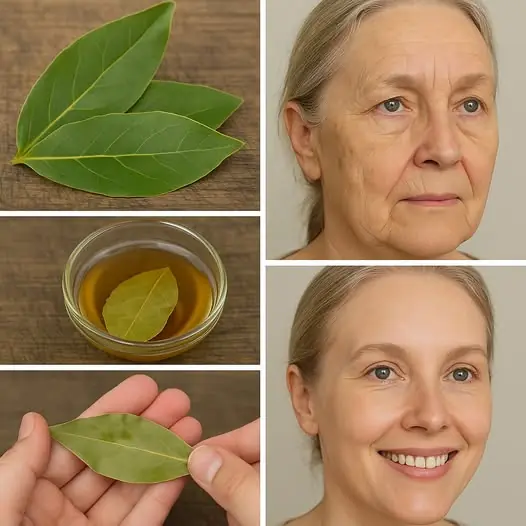
How to Prepare Fig Leaf Tea and Why You Should Drink It
For centuries, the fig tree has been valued not just for its sweet fruit, but also for its medicinal leaves—used in traditional remedies to support skin health, digestion, and cardiovascular function.
Why Fig Leaves Deserve a Place in Your Wellness Routine
Fig leaves may come as a surprise to many, but they’re not only edible—they’re packed with powerful nutrients. Rich in fiber, antioxidants, anti-inflammatory compounds, and antimicrobial properties, fig leaves can be transformed into a simple, healing tea.
How to Make Fig Leaf Tea
You’ll only need two ingredients:
-
1 handful of fresh fig leaves
-
½ liter (about 2 cups) of water
Instructions:
-
Wash the fig leaves thoroughly.
-
Add the leaves to a pot with half a liter of water.
-
Bring the mixture to a boil.
-
Let it simmer for 2–3 minutes.
-
Turn off the heat and let it steep for 10 minutes.
-
Strain and enjoy warm.
This tea can be consumed regularly, though it’s always best to start with small amounts to assess tolerance.
Potential Health Benefits of Fig Leaf Tea
1. Supports Skin Health
Fig leaf tea is often used in folk medicine to treat skin conditions such as eczema, vitiligo, and psoriasis. While clinical studies are limited, many of its benefits are attributed to its high content of flavonoids and polyphenols, which may reduce inflammation and promote healing.
2. Helps Regulate Blood Sugar
Thanks to its high potassium content, fig leaf tea may help the body absorb less sugar and require less insulin to process glucose. This makes it a promising natural aid for people managing diabetes or insulin resistance.
3. Eases Digestive Issues
Fig leaves are an excellent source of dietary fiber, which promotes healthy, regular bowel movements. This may help relieve constipation, bulk up stools, and stabilize irregular digestion.
4. Boosts Heart Health
Besides potassium, fig leaf tea also contains vital minerals like calcium, iron, and manganese. These contribute to cardiovascular wellness by helping regulate blood pressure and improving blood vessel function.
Additional Reported Benefits
Traditional uses of fig leaf tea suggest it may also:
-
Relieve ulcers
-
Calm bronchitis symptoms
-
Treat warts
-
Neutralize free radicals (unstable molecules that damage cells)
-
Strengthen bones
-
Protect liver function
-
Reduce swelling and inflammation
Safety & Precautions
Fig leaf tea is generally considered safe for most people when consumed in moderation. However, due to limited scientific data on ideal dosage and long-term use, it’s best to:
-
Start with small servings
-
Avoid use during pregnancy or breastfeeding unless advised by a healthcare professional
-
Consult a doctor if you have underlying health conditions or take medication
Conclusion
Fig leaf tea is an easy, natural remedy with a long history of traditional use. Whether you’re looking to improve your digestion, balance blood sugar, or soothe your skin, this simple herbal infusion might be a helpful addition to your routine. Just remember—natural doesn’t always mean risk-free, so enjoy it wisely.
News in the same category


The Incredible Health Benefits of Goosegrass (Crowfoot Grass)

Hibiscus and Lemon Tea: A Refreshing Remedy with Powerful Health Benefits

With This Natural Mix, I Ended 70 Years of Diabetes and Poor Blood Circulation – No More Pills Needed

Unlock the Hidden Powers of Dandelion Root 🌿✨

GINGER TEA

PLANTAIN: Take Advantage of Its Benefits and Learn How to Use It! 🌿

If You Suffer from Diabetes, High Blood Pressure, High Cholesterol, Inflammation, or Premature Aging — This Simple Homemade Remedy Could Change Your Life

Exploring the Amazing Benefits of Turmeric

7 Persistent Minor Illnesses That Could Be Early Warning Signs of Cancer

Natural Liver Detox Tips

I’m Losing So Much Belly Fat Drinking This All Day! 🌿 My Big Belly Is Gone – Thanks to Ginger!

10 Clues Your Body Might Be Giving You About Clogged Arteries

Warning signs of a heart attack?

8 powerful anti-cancer foods you should start including in your diet

What Happens to Your Body When You Drink Lemon Peel Tea?

Discover the Powerful Benefits and Uses of Thyme

The Leaf That Lowers Blood Pressure, Soothes the Stomach, and Boosts Immunity 🌿

Fatty Liver Diet: Nutritionist Recommends 5 Key Foods to Detox the Liver and Reduce Fat

Thousands May Be Living with Undiagnosed Alcohol-Related Brain Damage
News Post

The 4 Golden Hours to Drink Coffee for Maximum Health Benefits — From Liver Detox to Better Digestion

The Incredible Health Benefits of Goosegrass (Crowfoot Grass)

Hibiscus and Lemon Tea: A Refreshing Remedy with Powerful Health Benefits

With This Natural Mix, I Ended 70 Years of Diabetes and Poor Blood Circulation – No More Pills Needed

Unlock the Hidden Powers of Dandelion Root 🌿✨

Discover the Magic of Ginger Tea

THE DRINK THAT CLEARS ALL YOUR CLOGGED VEINS, CURES CANCER AND DIABETES — THIS DRINK WILL HEAL ALL YOUR DISEASES IN THE BLINK OF AN EYE. JUST ONE SERVING AND YOU’LL FEEL YOUR ILLNESSES DISAPPEAR FROM YOUR LIFE

Say goodbye to urinary infections, asthma, diabetes, poor circulation, fatty liver, and high blood pressure

15 best fruits for all health problems

Bay Leaf: The Natural Secret to Youthful Skin!

Natural Remedies for Managing Flu Symptoms

If you suffer from diabetes, high blood pressure, cholesterol, bloating, or premature aging, this homemade remedy could change your life.

The drink that unclogged my veins, eliminating poor circulation and high blood pressure. If you want to heal from cancer, diabetes, poor circulation, fatty liver, high blood pressure, stomach problems, constipation, and lack of energy — this drink is fo

GINGER TEA

How to Use Rice and Almond Oil to Get Rid of Wrinkles

PLANTAIN: Take Advantage of Its Benefits and Learn How to Use It! 🌿

If You Suffer from Diabetes, High Blood Pressure, High Cholesterol, Inflammation, or Premature Aging — This Simple Homemade Remedy Could Change Your Life

Exploring the Amazing Benefits of Turmeric

10 DIY Beauty Ice cubes for Face, Glowing Skin
